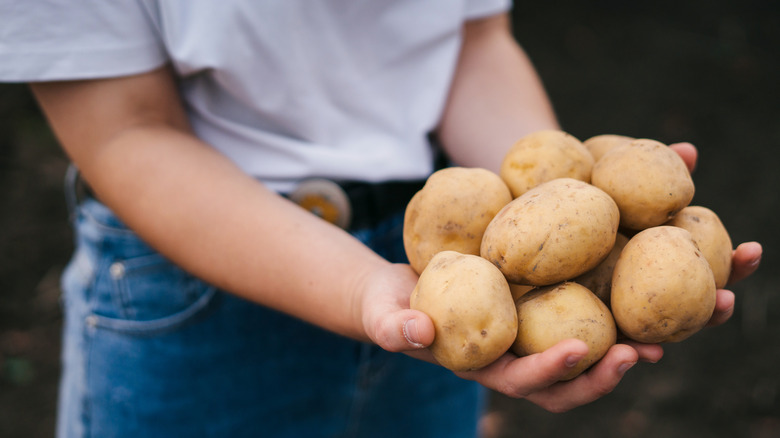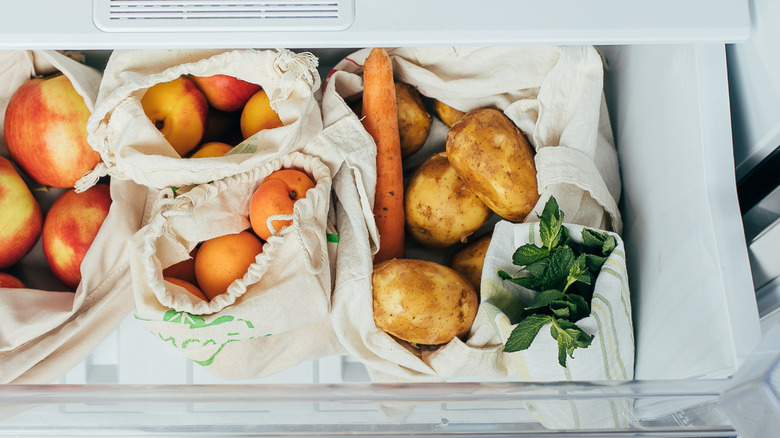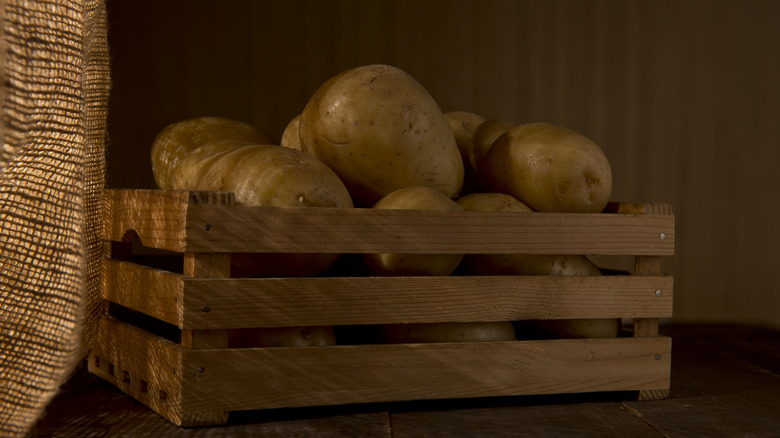Ingenious Potato Storage Solutions To Try If You Don't Have A Root Cellar
In the southern American states, homesteaders, preppers, traditionalists, and people who are just plain frugal eventually learn a painful lesson: Root cellars really don't work in their warmer climate. In Florida, YouTuber Petrina Steacy notes that you can't even fall back on the most popular alternative, a corner of your basement, since few homes in the state even have a cellar. That doesn't mean that keeping storage vegetables — and particularly root vegetables and tubers like potatoes — is out of the question. Looking for a solution, Steacy methodically tried two basic approaches: Storing potatoes in the house, and storing them in a garage fridge. What she found out surprised her, along with everyone else who thinks they know how root cellars are supposed to work.
Inside her home, Steacy tried a couple of storage variations, amounting to the coolest room and a more or less arbitrarily chosen laundry room. She wrapped her Yukon Gold, CalWhite, and Golden Nugget potatoes in newsprint or brown paper bags and stowed them away for four months in these two areas. She basically found that some potato varieties held up perfectly well, while others sprouted a bit. Meeting only one of the common root cellar requirements — darkness — didn't seem to hamper some potatoes much. But her next finding was far more unexpected: They kept well in the fridge.
The revolutionary idea of keeping food in a fridge
It might sound silly to say that storing potatoes in a paper bag in a refrigerator is "ingenious," but it's not quite as simple as that. First of all, potatoes don't typically fare well when refrigerated. And second, she used a garage fridge that had been adjusted to maintain a temperature of about 45 degrees. All of the potatoes she stored were perfect after four months. And since these vegetables prefer mesh bags (they should never be stored in plastic), you might get even more mileage out of them if you make sure to never open the fridge.
The explanation might not lie in anything Steacy did but in the sheer number of factors that determine when a potato rots or sprouts. Temperature and humidity control, ventilation, and darkness are commonly thought of as the key benefits of a root cellar for preserving tubers, root vegetables, and other stored greens. But there are other potential factors that might be just as (or more) important. Gas composition, for example, can trigger sprouting in potatoes, and research has shown that certain levels of oxygen and carbon dioxide can stimulate the process. Another factor is the age of the potato. Time encourages these vegetables to sprout, absent any storage factors that inhibit them. And there are other complications. Potatoes like humidity, but too much moisture will induce sprouting.
Does it make sense?
Though it might seem difficult to understand why Petrina Steacy's garage fridge experiment worked, it's not exactly surprising. Root cellars are used based on the fact that they work well, not on the premise that they are ideal, so other storage methods can work. But there are considerations to take into account. Even if her refrigeration method can be consistently reproduced, for example, you'd need a second fridge — the 45-degree temperature isn't safe for food storage. Steacy notes that you might be able to use a miniature model to save money on power consumption.
Then there are the numbers. Based on September 2024 electricity prices from the U.S. Energy Information Administration, the cost to run a 90-watt mini-fridge in Florida for one month is about $3.08 — presumably a little less for a fridge set to maintain a 45-degree temperature. For six months of storage (assuming it works for that long), $18 isn't necessarily outrageous. At current prices, that's about 35 pounds (or seven 5-pound bags) of baking potatoes.
Assuming those 24 pounds of potatoes fit and the fridge, labor, soil amendments, fertilizer, and water are all free, you'd merely break even storing your potatoes this way. Statista says Americans eat 30 pounds of fresh potatoes a year, so this would cover one person, but probably not a family. You'd still end up supplementing your potato cravings at the supermarket, and that's without even using any precious potatoes to clean your shower. Since they're so easy to grow that you can plant them in a laundry basket, it seems a shame for a gardener to resort to the produce aisle before winter's end.


